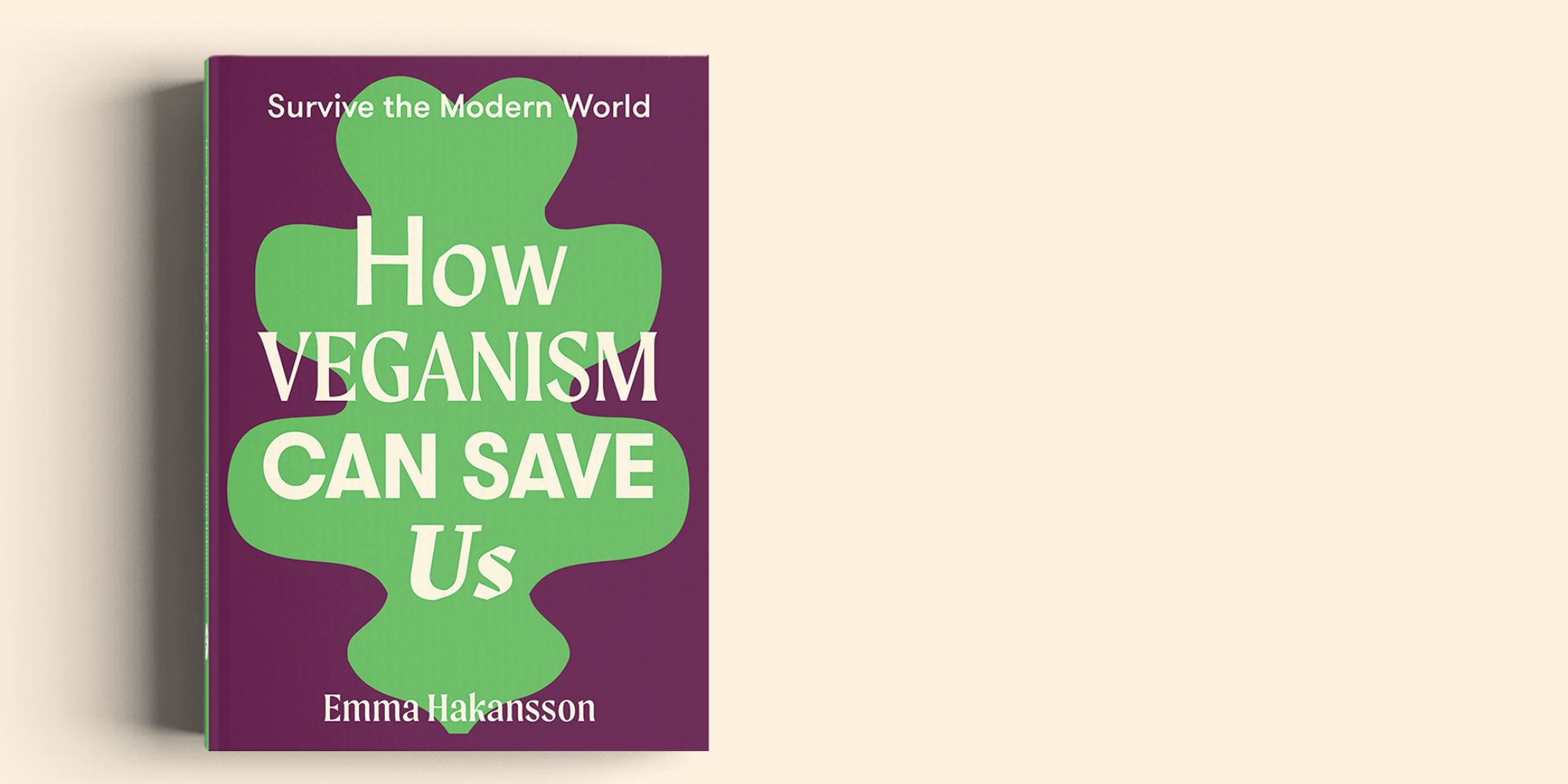We sat down with activist and author Emma Hakansson, founder of Collective Fashion Justice, to chat about her new book, How Veganism Can Save Us. We dive into the links between veganism and fashion and how she believes it can help address inequalities for people, the planet, and animals.
Meet activist and author Emma Hakansson
Animal agriculture has devastating impacts on people, the planet, and of course, animals—and it is intrinsically linked to the fashion industry. From the immense suffering of animals in supply chains to the enormous amounts of greenhouse gas emissions caused by factory farms to the long-term mental health impacts on slaughterhouse workers, fashion has a lot to answer for in this space.
While conversations in this space often centre on material selection, one Australian activist is challenging what many people think they know about vegan fashion and veganism overall. Emma Hakansson’s new book How Veganism Can Save Us takes a wide-angle look at the world of veganism—a growing movement that both abstains from animal products across food, fashion, and entertainment, and rejects the commodity status of animals.
As the founder of the non-profit Collective Fashion Justice, Hakansson has made it her mission to spread the word about collective liberation in the fashion industry—mainly focusing on the rights of non-human animals.
So can veganism really save us? We chatted to Hakansson about how the movement can inspire and empower us to take back control of our consumption habits and steer us in a more ethical direction.

9 Q&As on anti-speciesism and collective liberation
Q: What motivated you to write How Veganism Can Save Us? And who did you write your new book for?
A: I want to encourage people to see veganism and social justice through a broader lens. We often think of veganism as exclusively about food or non-human animals, but both are reductive ways of thinking about it.
The book is for anyone interested in social justice or a particular aspect of it but who might not have extended their circle of compassion to include non-human individuals.
And at the same time, I’m writing for the people who are vegan or interested in animal protection but who haven’t necessarily thought of how veganism sits within a broader social justice movement for people and the planet.
It’s about making people see a broader picture—where none of us are free until we all are.
Q: In a nutshell, what will readers take away from this book that they won’t find in the many other books about veganism?
A: The book brings people through the issues of veganism in a way that ultimately leaves them with a more holistic perspective on it.
It starts with the issues that first draw many people to veganism—like the climate crisis. But then it goes deeper into those that are less explored. Throughout, we get into questions like, “how are people who work in that system impacted?” Whether they’re slaughterhouse workers who are traumatised by the nature of their job, farm workers, tannery workers, all of those people we don’t really think about or consider part of that system.
The book not only looks at animal issues in the standard way that explores what happens to animals in different systems but ends with making us consider what being an animal means and how humans fit into that. And how, if we are talking about liberating people, we’re ultimately talking about liberating animals as well.
Q: The title of the book is sure to spark some heated conversations. Can veganism really save us? Or are you hoping the title accomplishes something else?
A: If we could have a title that was 50 words, it would’ve been something about how veganism will save us if we see it as this critical aspect of a more holistic movement for radical social change. But, of course, we can’t have a title that’s 50 words, so we have a title that’s about making people think.
It’s definitely a bit clickbaity in that, at first glance, some people will probably have an issue with it, but there’s a goal with a title like that. It’s about making people consider what the roots of veganism are.
Veganism is rooted in collective liberation where animal rights are all of our rights and there's no species boundary when we are talking about protecting individuals.
Veganism is rooted in collective liberation where animal rights are all of our rights and there's no species boundary when we are talking about protecting individuals.
When I talk about veganism, my definition is rooted in collective liberation, where animal rights are all of our rights, and there’s no species boundary when we are talking about protecting individuals. And when we’re talking about animals, we’re not just talking about farmed animals, but the animals that live in the wild that we need to protect when we are protecting nature.
Q: Veganism is more mainstream than ever before, but it remains a niche movement, mostly in well-off countries. What’s holding veganism back from becoming more popular?
A: Wealthier countries with greater access to alternatives to animal products have a responsibility to change more than those contributing less and with perhaps fewer options—we shouldn’t be calling on other countries to go vegan before looking in our own backyard. At the same time, people often ignore the strength of veganism in other countries, those that aren’t white and that may be poorer.
Even though it’s not just about food, meat consumption is highest in high-income, often white countries. And that’s probably reflected in the amount of animal materials worn and other similar uses. The fact that more privileged countries have “more veganism” in some sense reflects the amount of impact we have. Wealthier countries have caused the most climate issues and have the most overconsumption. With that comes a responsibility to look at how we are going to change and not continue to oppress animals and commodify the planet.
Veganism is also often portrayed as this white [people] thing, but many of the movement’s roots are in India from long ago before any white person was calling themselves a vegan. The movement today and some of the theories we use can be rooted in work by activists across Africa, Asia, and some Indigenous communities—we just need to amplify their work.
Ultimately, the increased popularity of veganism will be about people understanding the cultural conditioning we have that normalises the immense cruelty we accept now. Peeling that back will be how we see popularity in the vegan world come about.

Q: You have a background in fashion and are the founding director of not-for-profit Collective Fashion Justice—how does veganism relate to fashion?
A: We typically think about veganism in relation to food, which we should—we eat three times a day. But beyond food, countless animal species are killed, exploited, skinned, and objectified in the fashion industry. Humans who work in the industry also suffer, and all of that injustice needs to be addressed.
Many people—myself included—are passionate about ensuring that everyone who works in the fashion industry is autonomous, safe, and treated fairly and without coercion. That’s a really core value in the ethical fashion space. And if we extend that value beyond our human species boundary, we would see so much more of the industry is out of whack, and there’s no body autonomy or consent for any of those non-human animals in fashion, either.
If we are talking about not sustaining injustice and if we are recognising that people and other animals are a part of nature, veganism is a part of that, human rights are a part of that.
If we are talking about not sustaining injustice and if we are recognising that people and other animals are a part of nature, veganism is a part of that, human rights are a part of that.
And it’s not only about farmed animals and factory farming. It’s about wild, free-living animals, the environmental harm caused by ultra fast fashion, habitat destruction, emissions by leather and wool, and fossil fuel extraction for synthetics.
Collective Fashion Justice’s “total ethics fashion” term is about recognising how complex and intertwined veganism in fashion is. The way we talk about sustainability now is usually just about the planet, but we’re coming to realise that humans have to be a part of that. But if we are talking about not sustaining injustice and recognising that people and other animals are a part of nature, veganism is a part of that, human rights are a part of that.
Q: What tips do you have for people wanting to get more into vegan fashion? How do you build a more vegan wardrobe?
A: Each person has to make their own decisions about how to approach it. You don’t have to go out and buy a whole new wardrobe. You can buy second hand and look for vegan materials, both new and used.
While I think we need to evolve beyond the idea that skins are materials, I also don’t want people to read [the book] and be like, “Oh, I’ll just buy a million vegan fashion things.” Overconsumption is really glorified—you don’t have to go and replace everything right now. At the same time, I don’t wear any animal-derived materials I used to have because I don’t see them as materials anymore.
I used to wear my vintage Doc Martens that I’d had forever, and they’d existed long before me. But then I rescued a cow, and I was petting her, and she licked my foot, licked the skin of another cow who was dead. And I was like, “that’s gonna be enough for me. I don’t think I can wear any of these ever again”. But we shouldn’t just send them to waste, and that’s a whole other discussion.
You can also buy a vegan wardrobe without buying new—I got my vegan leather jacket from Depop! There’s this funny thing where people often say, “I would always choose second hand over vegan fashion,” but you can actually do both of them at the same time.
[Laughs].
When it comes to materials, look at the Good On You material guides and the Collective Fashion Justice resources because some alternatives are a lot better than others. And we have to keep all of those aspects for people, animals, and the planet in mind when we are looking at them.
Q: A lot of people who otherwise support sustainability are still turned off by the “vegan” label. How do you bring them into the conversation?
A: Some people are turned off by the vegan label because it confronts them, and it’s easy to feel guilty about what you’ve done up until you’ve known better. And many people feel that discomfort around veganism because maybe there’s part of them telling them they’d like to do something different.
People see that, and they're like, this whole vegan thing's a sham, but that's just brands doing the wrong thing.
People see that, and they're like, this whole vegan thing's a sham, but that's just brands doing the wrong thing.
But also, many brands that aren’t doing the right thing and don’t at all care about what veganism really stands for have a lot to answer for in this space. Look at PVC shoes made with sweatshop labour sold by, for example, Missguided or Boohoo. They are probably made using non-vegan dyes and glue, and they shouldn’t be able to label their products like, “Hey, look, it’s vegan! And here’s a green leaf to show that everything’s great.”
People see that, and they’re like, this whole vegan thing’s a sham, but that’s just brands doing the wrong thing. It doesn’t mean that this movement for total liberation and protecting animals isn’t valid. So I think decoupling that is a good way to make the conversation more genuine.
Q: What part of the book did you have the hardest time writing? And what part was the most fun to write?
A: The most challenging parts were those outside my area of expertise where I needed to talk to someone because I’m not a doctor, and it’s about health, for example. But the last part of the book, the “Animal Issues Are Our Issues” part, really looks at who we view as animals and the idea of personhood as a political identity, which has racial roots. And I’m not the person to go off and assume I know all about that. So that was the part where I had to speak to the most people, read the most work from other people, and do a lot of referencing of their work.
Christopher Sebastian is the person who I gushingly acknowledge because his work is vital to that space. That was the most difficult because it changed the way I think the most. But it was also the most stimulating because it was fascinating and important to learn about.
Q: What did you learn when writing this book?
A: There are so many different kinds of intersections that I looked at more deeply [when writing this book] that I thought were fascinating. There’s a section on class and veganism and how those two things relate; there’s a section around how toxic masculinity feeds into veganism, all of those things that seem really niche. But when you pull them out a bit more, they are actually really prevalent in our lives.



















